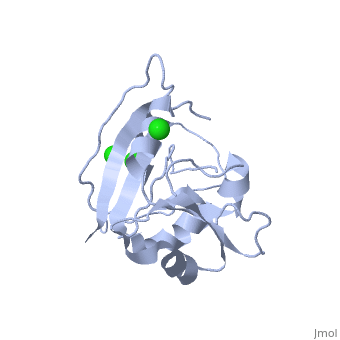Molecular Playground/DnaK
|
One of the CBI Molecules being studied in the University of Massachusetts Amherst Chemistry-Biology Interface Program at UMass Amherst and on display at the Molecular Playground.
Molecular Playground banner: DnaK, a central hub in maintaining proteostasis in E. coli
The E. coli Hsp70, DnaK, is a crucial protein chaperone whose function is to reduce bind exposed hydrohpobic residues of unfolded proteins, which prevents aggregation and rescues the nascent chain from kinetic traps along the folding pathway. Hsp70 protein chaperones switch between an , low-substrate affinity form and an , high substrate affinity form during their allosteric cycle.[1] [2] Hsp70 protein chaperones are ubiquitously found in almost all known organisms and cell types and represent a potential target for anti-cancer and neurodegenerative therapies.[3]
StructureStructure
DnaK is a 638 residue protein of approximately 70 kDa. The protein can be thought to be made up of two domains, the N-terminal nucleotide-binding domain () (residues 1-388), the C-terminal substrate-binding domain () (residues 393-638), which are divided by the (residues 389-392, shown in purple). The NBD is further divided into four subdomains: (residues 1-37, 112-184, 363-383, shown in red), (residues 38-111, shown in green), (residues 185-227, 310-362, shown in gold), and (residues 228-309, shown in purple). The SBD of DnaK consists of a (residues 393-507), an (residues 508-605), and a disordered C-terminal tail (not shown due to lack of available crystal structure). [4]
FunctionFunction
DnaK binds stretches (7-8 residues in length) of exposed hydrophobic residues of its client proteins in order to prevent their aggregation.[5] Upon ATP binding, the NBD subdomains rotate relative to each other and induce a conformational change in the NBD (compare the NBD to the form (shown with ATP bound). When ATP binds the NBD, the interdomain linker communicates the allosteric signal to the SBD that induces a conformational change in the SBD. Compare the form of the SBD (when the NBD binds ATP) and the form of the SBD (when the NBD binds ADP).[6] The SBD has low substrate affinity in the 'open' conformation, but high substrate affinity in the 'closed' conformation.[7] Alternating cycles of binding and release allow DnaK to unfold kinetically trapped intermediates and allow the client protein to refold to its native state.[8]
Drug TargetDrug Target
Since DnaK is critically positioned in the proteostasis system of many organsims it has been the target of choice for anti microbial and anti cancer therapy. Inhibitors of this enzyme are essentially folate mimics, methotrexate which was first designed to inhibit and used as therapy for cancer and autoimmune disorders. Another folate mimic Trimethoprim was developed as an anti bacterial agent, having much more binding specificity to bacterial DHFR than its mammalian counterpart. Both drugs bind in the active site of the enzyme and are irreversibly bound thus ablating enzyme activity.[9] [10].
3D structures of DHFR3D structures of DHFR
See AlsoSee Also
The Wikipedia page on Hsp70 is also pretty useful for a general background.[[11]]
ReferencesReferences
1. Kityk, R. et al. Mol Cell 2012
2. Bertelsen EB. et al. Proc Natl Acad Sci USA 2009
3. Broer L. et al. J Alzherimers Dis 2011
4. Zuiderweg ER. et al. Top Curr Chem 2013
5. Wegele H. et al. Rev Physiol Biochem Pharmacol 2004
6. Swain JF. et al. Mol Cell 2007
7. Mayer MP. Trends Biochem Sci 2013
8. Sharma SK. et al. Nat Chem Bio 2010
